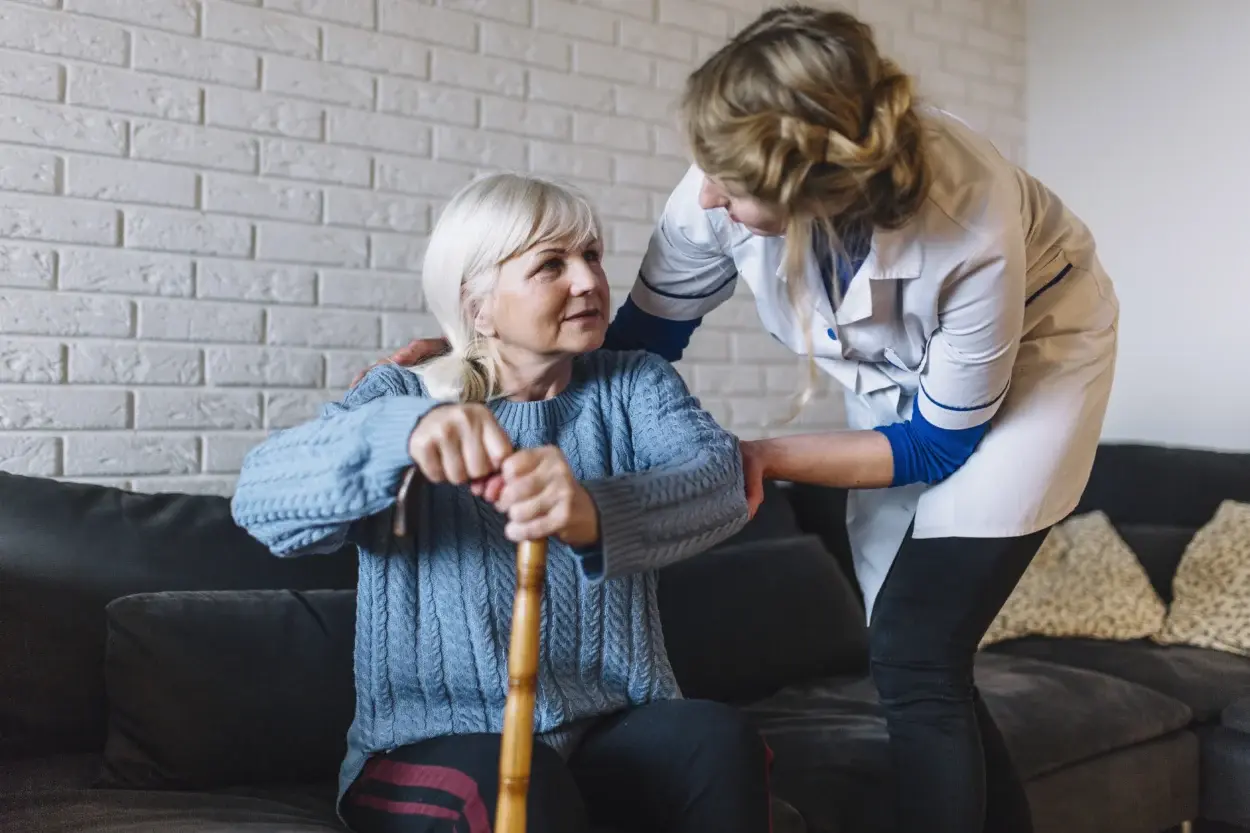The golden years are supposed to be filled with relaxation and enjoyment, but they can quickly become challenging if your home isn’t adapted to meet your changing needs. As we age, decreased mobility, vision loss, and other health issues can make any simple daily tasks difficult. However, with the right aged care home modifications, you or your loved one can comfortably and safely age in place.
This article will explore how to make your house more senior-friendly so you can continue living independently. We’ll cover:
- Common challenges seniors face at home
- Essential home modifications for aging in place
- Tips for paying for home renovations
- Hiring professional modification services
Arm yourself with information so you can take control of your home environment. With the right changes, your home can be a safe, accessible, and comfortable sanctuary for years to come.

The Challenges of Aging at Home
Our homes become very familiar to us over time. We know just how many steps lead up to the front door and we can navigate each room blindfolded. However, as we age, this familiarity can start working against us. Parts of our homes that we never used to think twice about can turn into major hazards or impediments.
Here are some of the most common challenges faced by elderly household member:
Decreased mobility- Conditions like arthritis can make climbing stairs difficult or painful. Additionally, individuals may face obstacles navigating narrow doorways and hallways, impacting their ability to move freely within their home environment. These mobility limitations can significantly affect daily activities and independence.
Fall risks- Fall risks are heightened due to impaired balance and vision, making falls more likely, especially on stairs or slippery surfaces like tile floors. Additionally, rugs and clutter can also pose tripping hazards, further increasing the risk of falls within the home environment.
Reduced strength and dexterity- Opening doors, jars, and faucets can be difficult. Carrying laundry or groceries upstairs may become impossible without assistance. These challenges can impact daily activities and may necessitate adjustments to the home environment to enhance accessibility and independence.
Vision loss- Aged individuals can face challenges with poor lighting, glare, and low contrast, making it hard to see edges like curbs and steps, as well as difficulty in reading medication labels.
Hearing loss- Sounds like alarms and doorbells may go unnoticed as we age. Additionally, the lack of visual cues makes conversations challenging, further impacting communication and social interactions.
Fortunately, numerous home modification methods are available to adapt our living spaces and mitigate the effects of aging. The primary focus is on maximising accessibility, safety, and convenience to ensure a comfortable and functional living environment for individuals as they age.

Essential Aged Care Home Modifications for Seniors
Not all seniors will need the same aged care home modifications. The changes you make should be based on you or your loved one’s specific needs and challenges. Here are some of the most essential upgrades to consider when seeking senior housing assistance:
Improve accessibility- For easy movement within the house, start by installing grab bars, railings, and ramps. Clear the clutter from hallways and stairs to create unobstructed pathways. Consider widening doorways to accommodate wheelchairs or walkers. And opt for lever-style handles which are easier to operate compared to knobs.
Increase lighting- Enhance lighting throughout the home by increasing wattage in existing fixtures and adding task lighting where needed. Install night lights in hallways, bathrooms, and bedrooms to improve visibility during nighttime. Additionally, consider installing lighting controls that are easy to operate for added convenience.
Update flooring- Replace old carpeting with low-pile versions without padding. Install slip-resistant sheet vinyl or tile flooring, particularly in areas prone to moisture. Use contrasting colours on floors and trim to indicate changes in level or transition areas.
Renovate bathrooms- Install walk-in showers with seats and grab bars. Replace bathtubs with low threshold walk-in models. Install adjustable shower heads and hand-held shower wands. Choose easy-grip lever faucets and drains.
Improve kitchen safety- Lower or replace upper cabinets to improve accessibility. Install pull-down shelving for easier access to items. Replace appliances with front-control models. Use induction cooktops to reduce burn risk. Install lever faucets and easy-open cabinet hardware as it is advantageous to individuals with limited mobility.
Add smart technology- Install video doorbells and remote locks to see and allow visitors without opening doors. Use voice controls or smart devices to control lighting, temperature, and security.
Other modifications- Lower closet rods and shelves. Replace doorknobs with levers. Install a medical alert system. Secure rugs and use slip-resistant backing. Mark edges of outdoor steps and paths with bright paint.
By prioritising improvements in all the above essential aged care home modifications, you can create a safer and more comfortable living environment conducive to aging in place.

Financial Assistance for Aged Care Home Modifications
Paying for home renovations can be a major barrier, especially for seniors on fixed incomes. Here are some options to help fund needed changes:
Government programs – Medicaid waivers, veteran’s benefits, and housing grants may offer financial assistance for aged care home modifications. To explore these options, individuals can contact their local Area Agency on Aging, which can provide guidance and support in navigating available resources.
Tax credits – In addition to government programs, individuals may also be eligible for federal tax credits and deductions, as well as state-specific tax credit. These incentives can help offset the costs associated with making necessary aged care home modifications.
Reverse mortgage – For those aged 62 and older, a reverse mortgage gives another avenue for funding home renovations. By converting home equity into cash, individuals can finance accessibility upgrades to enhance their living environment and quality of life.
Loans – Some banks offer special loans tailored for accessibility remodelling projects. Consider shopping around and comparing rated to find the most suitable financing option.
Long-term care insurance – Individuals with long-term care insurance policies should review their coverage to determine if home modifications are included as part of their benefits. This can provide financial assistance for necessary changes to accommodate changing mobility needs.
Budget carefully – Finally, budgeting carefully and saving up for needed changes is an effective strategy for financing aged care home modifications. Prioritise modifications based on their impact and urgency as it can help individuals allocate funds effectively and make meaningful improvements to your living spaces.

Hiring Home Modification Professionals
Unless you’re doing very simple renovations, it’s advisable to enlist experienced professionals for home modification services for seniors. Here’s how to find the right contractor for the job:
Seek specialists – Research and contact contractors who are specifically focused on accessibility, aging in place renovations.
Verify credentials – Contractors should be licensed, bonded, and insured. Make sure they comply with any state licensing requirements for your aged care home modifications.
Check references – Speak to other customers about their experience, quality of work, and timeliness. Begin by reviewing online ratings.
Obtain multiple quotes – Interview at least three contractors and compare project bids and timelines. Make sure bids cover all expected costs.
Ask questions – Confirm who will do the work and how long the project should take. Understand any warranty coverage associated with the modifications.
Review contracts – Carefully review contracts to understand all terms and costs, and if everything suits your needs, sign the contract to modify your safe and comfortable home.

Aging in Place Comfortably
Adapting your home to meet your changing needs is one of the best investments you can make. With some creativity and planning, you can modify your space to allow you to comfortably and safely age in the home you love. Reach out to a professional contractor if you need help developing a renovation plan tailored your specific situation and budget.
While tackling home projects can be daunting, remember that small, targeted changes can make a huge difference. Focus on the modifications that have the biggest impact for you. Even modest improvements like adding grab bars in key areas can prevent falls and allow you to live independently longer.
Your home should serve as a sanctuary where you always feel secure and empowered. By implementing the right modifications, for yourself or your loved ones, you can cultivate an environment conducive to thriving well into the golden years. With careful consideration and well-designed elderly care services at home Townsville your home can continue to evolve alongside your changing needs, fostering a sense of stability and well-being for years to come.
Conclusion
Ultimately, the goal is to cultivate an environment where seniors feel secure and empowered, allowing them to thrive in the comfort of their own homes. With thoughtful adjustments and targeted modifications, individuals can embrace the golden years with confidence and enjoy a fulfilling lifestyle for years to come.
Bur-del offers specialised aged care home modifications in the Burdekin and Townsville regions. Our mission is to provide compassionate and comprehensive care, ensuring seniors receive personalised assistance and support in a safe environment. We aim to enhance their quality of life by fostering independence and dignity. Our vision is to be the leading provider of aged care services, renowned for our dedication to excellence and for creating a warm, welcoming atmosphere where seniors can thrive.



